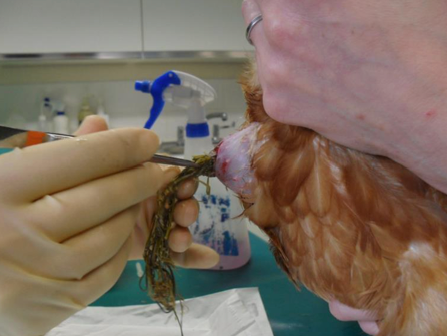



Crop disorders of chickens I: Crop impaction
Learn about crop impaction and its treatmentThe crop is an enlarged part of the esophagus located to the right of the trachea at the thoracic inlet. The walls of the crop are thin, and the organ is attached to the skin and clavicle by loose connective tissue. There are 2 muscles that support the crop and aid in the emptying process. The main function of the crop is to store feed while the proventriculus and gizzard are full of feed.
Shortly after feed is ingested, it is normal for the crop to be distended and full of feed. As the feed in the gizzard is moved into the intestine, the crop begins to contract, emptying its content into the esophagus and supplying more feed to the proventriculus and gizzard.
Crop impaction occurs when the stored material cannot be propelled forward into the esophagus. Crop impaction normally develops when a group of fibers get tangled together into a mass that is too big to pass from the crop to the esophagus (picture 1).
Occurrence
Crop impaction is more common in free-range birds or in birds with access to pasture, long and tall grass, hay bale twine, or other similar materials that they could ingest. Birds that have not had access to fresh green vegetation over the winter are more likely to consume excessive plant matter such as grass clippings.
Birds that have been off feed for a long time may tend to over-consume and overfill their crops with dry poultry feed. This feed can increase in volume when the birds start drinking water adding additional pressure to the esophagus blocking the normal transit of feed.
Consumption of other foreign objects (long pieces of plastic or thread) can also occur and impede the normal emptying process of the crop. Sick birds, especially those with intestinal problems, are also more likely to consume large amounts of roughage or grit.
Clinical manifestations
Under normal circumstances, the crop will usually empty in 2-4 hours. In birds with crop impaction, the crop will not empty. On palpation, the contents of the crop will feel firm. Birds will show reduced appetite, weight loss, and depression.

Predisposing factors
Access to tall fibrous grass, sudden access to grass in birds that have been kept on commercial feed for most of their lives, and access to natural or synthetic strands of material that birds can consume. Birds that have been off feed for a long time may tend to overeat and overfill their crops with dry poultry feed.
This feed can increase in volume when the birds start drinking water adding additional pressure to the esophagus blocking the normal transit of feed. Consumption of other foreign objects (long pieces of plastic or thread) can tangle in the crop and obstruct the normal emptying process of the crop.
Prevention
If the birds will have access to pasture, keep the grazing areas cut short. Keep the area clear of non-feed material that could be consumed. Provide a source of grit.
Diagnosis
Palpation of the crop early in the morning before the birds have had a chance to eat will reveal content in the crop in the form of a mass with variable consistency.
Treatment
With early detection, a gentle massage of the crop may be all that is needed. Adding warm water into the crop before the massage can help to hydrate the content and make it softer. To inject water into the crop, a special needle is used: 1.5-2 inches long with a rounded blunt end that is approximately 3 mm in diameter. The rounded end is designed to prevent trauma in the oral cavity. If that needle is not available, any soft tubing connected to a syringe will suffice (although it may take longer) to direct water into the crop. Use ~3-10 mL of lukewarm water, depending on the size of the bird. Oil can also be added to the water as a lubricant.
Procedure
With the help of an assistant, hold the bird, open its beak, position the cannula at the side of the beak and move it forward, down the esophagus about 2 inches. Make sure the bird is breathing effortlessly. If the bird starts coughing, do not start adding water as the cannula may be touching the larynx or even be inside the trachea. If this happens, gently move the cannula backward for about ½ an inch, then move it forward for about one or two inches. Add a little bit of water and make sure the coughing reflex is not triggered. After verifying that the bird is breathing normally, add the rest of the water. Massage the crop gently for 3 minutes. The process may have to be repeated several times for a couple of days. If the previous treatment is unsuccessful, surgery is needed (picture 1).








